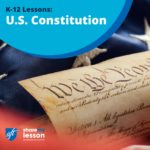Students who listen to this Grade 2 Core Knowledge History and Geography unit discover that Americans had a difficult task at hand after winning the Revolutionary War: they had to figure out a better way to govern themselves. Such leaders as James Madison, George Washington, Alexander Hamilton, and Benjamin Franklin traveled to Philadelphia to meet at the Constitutional Convention, with the goal of creating a new government. Students learn that the talks were held in secret in Independence Hall and that American leaders argued about many issues until they agreed to approve a new Constitution. They then hear that James Madison (whom we call the Father of the Constitution), along with John Jay and Alexander Hamilton, wrote the Federalist Papers to explain the document’s merits and to persuade the states to vote for it. Students find out that the states did finally approve the Constitution; that Madison wrote a Bill of Rights that was added to it; that the Constitution gives the American people the right to decide what the laws should be for our country; and that we can still amend it today.(5 lessons)
Article V: The Amendment Process
Article V of the Constitution says how the Constitution can be amended; that is, how provisions can be added to the text of the Constitution. The Constitution is not easy to amend: Only 27 amendments have been added to the Constitution since it was adopted. Discover how the amendment process works in the National Constitution Center’s learning module.
Civic Art Project: Notes on the Constitution
Students create art works based on an examination of the language of the Constitution and the personal connections they make. These art works will incorporate words, illustrations, and mixed media images.
This lesson can be adapted for different grade levels. High school students can use an abridged version of the U.S. Constitution. Elementary and middle school students can use the Preamble, or introduction, to the Constitution.
Constitution Day Activities & Lesson Plans

Get ready for September 17, Constitution Day, with these preK-12 Constitution Day activities and lesson plans on the U.S. Constitution. The Share My Lesson team has selected a variety of free lesson plans, educational resources, and classroom materials to support teachers in celebrating Constitution Day with their students.
Constitution Day Word Search
Here’s a fun activity for all ages with vocabulary that is tied to Constitution Day! Answers are provided as well!
Constitution: Analyze – Explore – Music
Students will engage in a study of the Constitution to learn about the nature and structure of the United States. The Constitution will be analyzed and discussed as a primary source to understand the form of government and principles of the U.S. This lesson provides students an opportunity to explore how the government works and what the Constitution means to them today. Students will create a song to demonstrate understanding of the Constitution and nature of the U.S. government. Constituting America has a song contest teachers may want to integrate with this lesson plan.
Constitution Clips
C-SPAN’s Constitution Clips makes the U.S. Constitution come alive by providing teachers and students with video clips from C-SPAN’s Video Library of the Constitution in action.
Choosing to Make a Nation: Constitutional Convention Simulation
The Choosing to Make a Nation Curriculum Project developed by award-winning author Ray Raphael is a student-centered, primary source-rich approach to teaching about American history and our nation‘s founding documents.
An 8-lesson simulation in which students become delegates from specific states and address the same issues the framers faced. Unit includes the following lesson plans –
(1) Reform or Revolution?
(2) Composition of Congress
(3) Creating an Executive Branch
(4) Should Judges Judge Laws?
(5) Balance of Powers
(6) Slavery and the Constitution
(7) Amendments and Ratification
(8) To Sign or Not to Sign?
Option A: The historical Constitution
Option B: Student-generated constitution
Constitution Day Writing Prompts – Middle and High School
Three writing prompts for Constitution Day are provided for middle school and high school. The prompts can be used as a formal essay, at writing stations, or as a “discuss and write.”
The Constitutional Convention: To Sign or Not to Sign (Option A: The Historical Constitution)
NOTE: This lesson depends on a prior study of the Constitution Convention and the plan it produced, whether that study has been based on ConSource’s Constitutional Convention Simulation lessons or other curricula. Students will not be able to make a reasoned decision on whether to sign the Constitution unless they know what it is they are asked to endorse. Classes that have engaged in ConSource’s Constitutional Convention simulation can engage with both “To Sign or Not to Sign: Option A,” which asks students to cast a final vote on the Constitution of 1787, and “To Sign or Not to Sign: Option B,” which asks students to cast a final vote on the student-generated constitution.